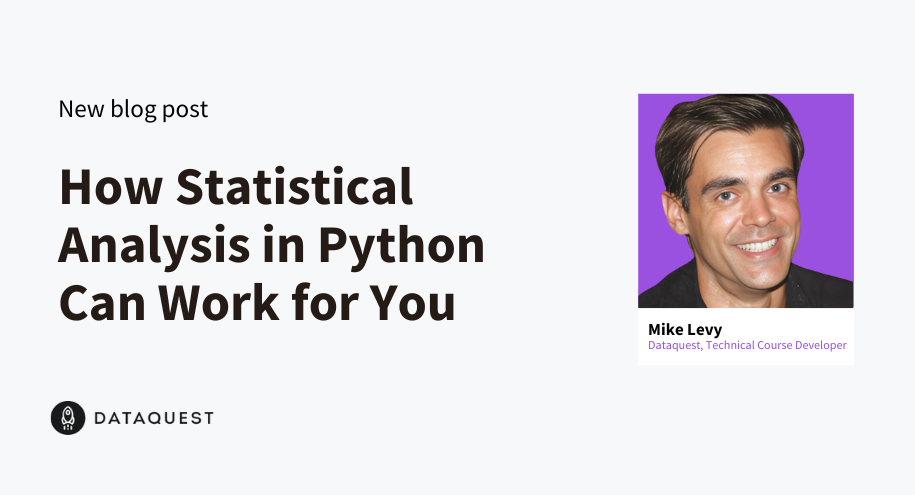Cyber Week Deal: Save $670 Off Lifetime Plan & Build a Future-Proof Data Career
The Dataquest Download
Level up your data and AI skills, one newsletter at a time.
Hello, Dataquesters!
Here’s what’s in store for you in this edition:
Statistical Analysis in Python: Discover 3 essential techniques that transform data into insights, with hands-on tips to practice right away. Read the article
Data Career Masterclass: In the last three sessions, we looked into how to prepare for your first data role, what makes a good data portfolio and how to create a standout data science resume. Check the recordings
Weekly Practice Challenge: Refine your data cleaning with this music playlist problem. Can you fix the playlist and get all the song details in order? Take the challenge
Inspiration From the Community: Explore Jack Kolberg-Edelbrock’s SQL and Python project on Analyzing Model Vehicle Sales. Learn more

Through years of practical experience analyzing data, I’ve learned that choosing the right statistical measures isn’t just about following rules—it’s about understanding what story you want to tell with your data and selecting the tools that will help you tell it most effectively.
Choosing the Right Measures of Central Tendency
When I first started analyzing data, I defaulted to using the mean for everything. It seemed simple enough—add up all the values and divide by the count. But I quickly discovered that this approach sometimes painted a misleading picture, especially when dealing with outliers.
For example, when analyzing student behavior patterns, I found that a few extremely long completion times were skewing our understanding of typical student progress. Switching to median measurements provided a much clearer picture of how most students were actually performing. This insight helped us make better decisions about course pacing and content structure.
What to do about it: Next time you’re analyzing a dataset, calculate both mean and median. If they differ significantly, look for outliers in your data. Create a box plot to visualize the distribution and identify any extreme values. Consider how these outliers might affect your conclusions and whether excluding them or using robust statistics might provide more accurate insights.
Understanding Variability in Your Data
Measuring central tendency tells only part of the story. By analyzing completion times across different courses, I discovered that understanding variability through standard deviation revealed patterns that averages alone missed. Some courses showed consistent completion times, while others varied widely—information that proved valuable for identifying areas needing improvement.
Standard deviation became particularly useful when examining student engagement patterns. Courses with similar average engagement rates sometimes showed very different patterns of variability, leading to different recommendations for course improvements.
What to do about it: Calculate the standard deviation for your key metrics. Look for patterns in variability across different groups or categories. Consider creating visualizations that show both central tendency and spread, such as violin plots or box plots. This combination will give you a more complete picture of your data’s behavior.
Standardizing Data for Meaningful Comparisons
One of the most powerful techniques I’ve learned is using z-scores to standardize different distributions. This approach transformed how I compared performance across markets with different characteristics. By converting raw scores to standardized units, I could identify trends and patterns that weren’t visible in the original data.
This standardization technique proved especially valuable when analyzing market potential. Markets that appeared unremarkable based on raw numbers sometimes showed promising characteristics when viewed through standardized metrics.
What to do about it: Practice converting your raw data into z-scores using Python’s statistical functions. Compare distributions before and after standardization to see how this transformation affects your interpretation. Look for patterns that might be hidden in the raw data but become apparent after standardization.
Join the Conversation
Remember, statistical analysis becomes more powerful when shared with others who can offer new perspectives. Join the Dataquest Community to discuss your analyses, share insights, and learn from fellow data analysts. Your questions and experiences might help others overcome similar challenges in their statistical journey.
Taking Your Statistical Analysis Further
Effective statistical analysis requires both technical knowledge and practical judgment. To develop these skills systematically, check out the Intermediate Statistics in Python course. You’ll work with real datasets and learn to apply these concepts in practical situations.
Final tip: Start with a small dataset you’re familiar with and apply these techniques one at a time. Document your findings and observations. This practical experience will build your confidence and intuition for statistical analysis.
Practice Challenge
Imagine you’re working with a messy playlist where song details are inconsistent and jumbled—your task is to tidy up the data so every song’s information is in perfect order. Can you fix the playlist, organize the details correctly, and get everything set for smooth playback?
This challenge will help you sharpen your data-cleaning skills, including handling text inconsistencies, organizing data fields, and preparing datasets for analysis or reporting. Ready?
Past Webinar Recording: Data Career Masterclass
Did you miss the live sessions of the Data Career Masterclass? Don’t worry—you can still catch up!
Sign up for the rest of the series to stay on track, and check out these previous sessions before the next one:
- Webinar 1: Preparing for Your First Data Job – Kishawna Peck shared valuable insights and her personal journey into data, offering a roadmap for aspiring data professionals.
- Webinar 2: Building and Presenting Your Data Portfolio – Practical tips on creating a standout portfolio to showcase your skills, especially if you lack formal experience.
- Webinar 3: Learn How to Craft a Standout Data Science CV – Gain valuable insights into crafting a data-focused resume, including how to showcase key skills, tailor for hiring managers, and optimize for ATS compatibility.
Catch up and get ready for the next session!
DQ Resources
📌 NumPy Cheat Sheet: Quick reference for essential NumPy functions, covering array creation, reshaping, Boolean filtering, and key statistics like mean and variance—ideal for efficient data handling. Download PDF
📌 Pandas Cheat Sheet: Handy guide for pandas essentials—from reading and writing data to grouping, sorting, and aggregating with examples from the Fortune 500 Dataset. Perfect for data manipulation and analysis. Download PDF
📌 SQL Cheat Sheet: Quick reference for essential SQL queries using tables like products, orders, and customers, with a database diagram for easy reference. Download PDF
📌 Python Cheat Sheet: A quick guide to key Python concepts—from variables and data types to functions and control flow—perfect for data analysis and programming. Download PDF
What We're Reading
📖 Building a Data-Driven Culture: Three Mistakes to Avoid
Learn about three common mistakes to avoid when building a data-driven culture in your organization. This article provides insights on how to effectively implement data science tools and cross-functional efforts to solve business challenges. Read more
📖 How to Use AI to Breathe Life into Modern Storytelling in 2024
Discover how AI is reshaping narrative creation, from generative AI to data visualization. This comprehensive guide covers AI storytelling tools, ethical considerations, and practical tips for leveraging AI in your storytelling process. Read more
📖 Generative AI is coming to Google Maps, Google Earth, Waze
Google’s new AI model, Gemini, will soon enhance Google Maps, Google Earth, and Waze. Maps will feature conversational searches, curated suggestions, and contextual directions. Read more
Community highlights
Project Spotlight
Sharing and reviewing others’ projects is one of the best things you can do to sharpen your skills. Twice a month we will share a project from the community. The top pick wins a $20 gift card!
In this edition, we’re spotlighting Jack Kolberg-Edelbrock‘s SQL and Python project on Analyzing Model Vehicle Sales. In this project, Jack investigated the data from a wholesaler that purchases scale-model vehicles. The work showcases professional project organization, smooth and detailed storytelling, interesting results, and compelling plots. This project is available on GitHub and is a great reference point for anyone starting with SQL.
Want your project in the spotlight? Share it in the community.
Give 20%, Get $20: Time to Refer a Friend!
Give 20% Get $20
Now is the perfect time to share Dataquest with a friend. Gift a 20% discount, and for every friend who subscribes, earn a $20 bonus. Use your bonuses for digital gift cards, prepaid cards, or donate to charity. Your choice! Click here
High-fives from Vik, Celeste, Anna P, Anna S, Anishta, Bruno, Elena, Mike, Daniel, and Brayan.
